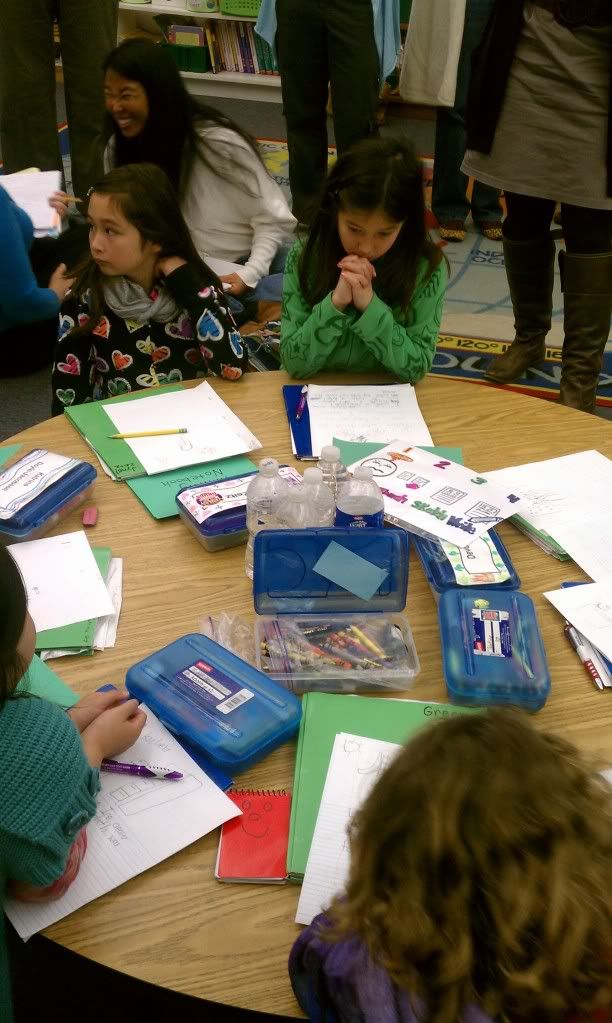Thursday, March 31, 2011
Monday, March 28, 2011
Getting Set for Writer's Workshop
Above is one more photo I'd like to share with you from my recent visit to a 2nd grade Writing Workshop in action. Consultant Renee Houser from Growing Educators, who was working with students, tacked up this poster. The set-up routine gets young writers ready, puts them in the right mind-set, and helps them focus on what they will be working on. I love the way this routine sets the expectation that serious writing will be taking place in this session!
Here's more from Renee Houser's hand-out:
Create rituals and routines around notebook work
such as:
* At the beginning of every writer's workshop, have students edit at least one entry as they sit and wait
for classmates to settle in the meeting area before the mini-lesson begins.
* Interrupt students in the middle of the independent work time and challenge them to accomplish a 'quick edit' (you might want to focus each quick edit for something specific each time such as: end marks, capitalization, word wall words, etc.).
* Provide time for students to reflect on their own note-booking. Perhaps they share their reflections and goals with their partners. Example: I date each entry. I fill the page margin to margin with my writing. I use my writing notebook only for writing. I tend to use ____ as a strategy because ____ .
* Building time during a 1:1 conference to invite students to share their notebook work and goals.
* Establishing some non-negotiables for notebooks such as: All entries are dated. Writing should be from margin to margin, etc.
Next, I will be blogging on one of my favorite subjects:
Book-making with beginning readers and writers. Stay tuned!
Monday, March 21, 2011
Becoming an independent writer. . .
As a continuation of my previous blog posting, I'd like to share some ideas
from writing consultant Renee Houser:
"We can live wide-awake writerly lives and capture these moments in our writing notebooks by:
- Writing about things that matter to you, you feel strongly about or perhaps want others to change or think about. . . let your voice be heard!
- Searching for an object on your body or in your surroundings that may spark a memory
- Time-lining part of your day
- Observing people, places, sounds. . .
- Collecting words, phrases, or parts of texts
- Rereading old entries and find more to say
- Rereading old entries in a way that it sparks a new or different memory
- Sketching a place and then write about it
- Making a list of things you want to write about, pick one and start writing
- Being inspired by photographs or artifacts
- Making a list of questions or wonderings and then search for answers or other questions and thoughts
- Saying it better. . . reread an entry and find a line or phrase you think you wrote well and write it again, better, clearer . . . "
Thursday, March 10, 2011
Scenes from 2nd Grade Writing Workshop
I was invited to my friend Renee Keeler's 2nd grade classroom to observe a model lesson (along with all the 2nd grade teachers in the district) with consultant Renee Houser. She trained with Lucy Culkins and is with a group called "Growing Educators." All the teachers met with Renee H. first, but there was a mix-up with the subs, so I, having a credential, volunteered to take over for a half hour. I read a biography of Dr. Suess, then the students read a version on their own. Notice the level of engagement. Loved it!
Here's Renee Houser, above, conferencing with a table of writers.
Renee's class is set up for "The Daily Five," so you can see lots of "busy brains" in the following photos.
This story is off to a great start! Notice how this child planned the story by drawing a picture first.
Renee Houser demonstrated how she uses a graph, below, to show how writing workshop time is divided. This is on display and referred to often. The sticky note star is moved to each section. Time is allowed for: Set Up (materials), Meeting (planning, mini-lesson), a big chunk of Independent Writing Time, Partner Work, more Independent Writing Time, and Wrap-UP.
Scenes from the classroom. I love the self-portraits and the Daily Five Posters.
Thursday, March 3, 2011
Scenes from CA Readers Luncheon on Feb. 26th, 2011
Subscribe to:
Comments (Atom)



















